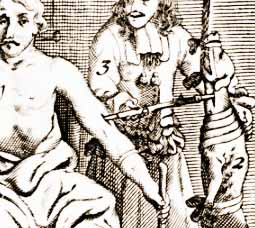The Beast Within: Animals in the First Xenotransfusion Experiments in France, ca. 1667-68
by Peter Sahlins
The essay begins:
The first practical experiments in transfusing animal blood into humans for therapeutic purposes—to cure sickness, especially madness, and to prolong life—took place in Paris in 1667 and 1668, and they worked. Or not. From the beginning, the experiments were shrouded in the competing claims of a highly public controversy in which consensus and truth, alongside the experimental dogs, lambs, and calves, were the first victims. “There was never anything that divided opinion as much as we presently witness with the transfusions,” wrote the Parisian lawyer at Parlement Louis de Basril, late in what became known as the “Transfusion Affair,” in February 1668. “It is a topic of the salons, an amusement at the court, the subject of philosophical dissertations; and doctors talk incessantly about it in all their consultations.” At the center of the controversy was the Montpellier physician and “most able Cartesian philosopher,” Jean Denis (1635–1704), recently established in Paris. With the experienced surgeon Paul Emmerez (?–1690), Denis performed transfusions, using primitive instrumentation, of small amounts of blood from the carotid arteries of calves, lambs, and kid goats into the veins of five ailing human patients between June 1667 and January 1668. Two died, but three were purportedly cured and rejuvenated. The experiments divided the medical establishment and engaged a Parisian public avid for scientific discoveries, especially medical therapies to cure disease and to provide eternal youth. For a moment at least, the Transfusion Affair fashionably eclipsed comets within an emerging “science for a polite society” in the late 1660s, and the attention of Paris turned to the therapeutic uses of animal blood, and of animals more generally. Continue reading …
 This article examines the attitudes toward animals and animal blood on both sides of the transfusionist debate and the resulting insistence on the “beast within” human nature that found a renewed expression at the beginning of the Classical Age.
This article examines the attitudes toward animals and animal blood on both sides of the transfusionist debate and the resulting insistence on the “beast within” human nature that found a renewed expression at the beginning of the Classical Age.
